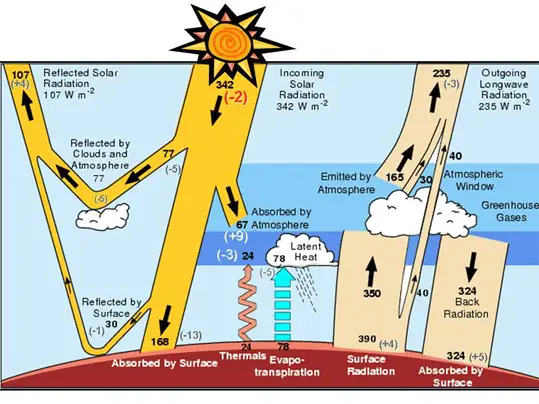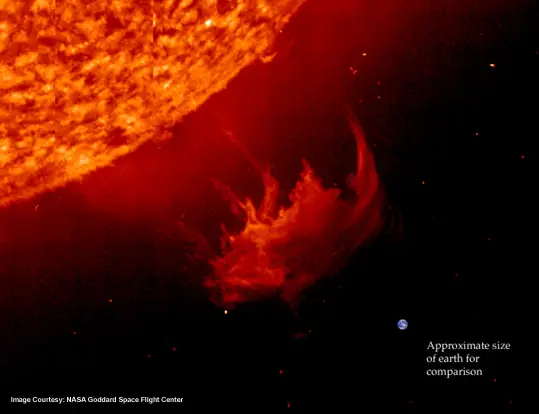Measuring Solar Activity: The driving force behind all of our weather on Earth is the sun. The uneven heating of the Earth’s surface by the sun influences the formation of different air masses and stimulates ocean currents. The continuous interaction between the sun, sea and the sky governs our weather and climate.
Unlike many other planets in our solar system, life on Earth is only possible because the climate conditions on Earth are relatively mild. The Earth orbits around our home star, the sun. Although the sun looks round, like a simple, spherical shape, we know today that the Sun varies in many ways. Solar phenomena such as flares and coronal mass ejections have an impact on the space environment of the Earth through a range of physical connections. Solar activity spans timescales of different length, from the well known 11 year solar activity cycle, the 27 days of solar rotation, down to sub-second timescales during eruptions. Monitoring and measuring solar activity along with evaluating its likely consequences for the near-Earth environment requires both a long term commitment as well as daily dedication.

Measuring Solar Activity – Ground Based
Solar energy received at the Earth’s surface can be separated into two basic components, direct and diffuse solar energy:
1. Direct solar energy is the energy arriving at the Earth’s surface with the Sun’s beam. The Sun’s beam is quite intense, and hence has also been described a “shadow producing” radiation. Direct solar irradiance is a measure of the rate of solar energy arriving at the Earth’s surface from the Sun’s direct beam, on a plane perpendicular to the beam, and is usually measured by a pyrheliometer mounted on a solar tracker.
2. Diffuse solar energy is the result of the atmosphere reducing the magnitude of the Sun’s beam. Some of the energy removed from the beam is redirected or scattered towards the ground – the rate at which this energy falls on a unit horizontal surface per second is called the diffuse solar irradiance. Diffuse solar irradiance is measured by a pyranometer, with its glass dome shaded from the Sun’s beam.
Solar radiation is a fundamental ingredient in maintaining the current climate, and also plays a major role in anticipated changes in our climate. Aerosol optical depth, measured using a sunphotometer, helps quantify the role of aerosol in radiatively forced climate change.
Measuring Solar Activity Using Satellites
The radiant energy emitted by the sun can be observed, and this quantity is referred to as the solar irradiance. Irradiance can be defined as the amount of electromagnetic energy incident on a surface per unit time per unit area. Solar refers to electromagnetic radiation in the spectral range of approximately 1-9 ft (0.30-3 m), where the shortest wavelengths are in the ultraviolet region of the spectrum, the intermediate wavelengths in the visible region, and the longer wavelengths are in the near infrared. Total means that the solar flux has been integrated over all wavelengths to include the contributions from ultraviolet, visible, and infrared radiation.
As the sun warms Earth, it prompts a chain of chemical reactions in the middle and upper atmosphere. These reactions change the transparency of the atmosphere, causing other changes at lower altitudes; greater fluxes of damaging ultraviolet radiation may pass to the ground, or infrared radiation (heat) emitted by the ground may be trapped rather than emitted, as in a greenhouse.
The first concern is the total energy flow since life on Earth is so dependent on the constant sun emitting energy within a narrow range. Even a 0.1 percent shift in either direction could have a noticeable effect on the average temperature of the Earth and hence its climate. Yet measurements made to date vary by as much as 5 percent because of differences among and within instruments. Since the atmosphere is an unpredictable filter, these measurements can be made accurately only from orbit.
The Solar Radiation and Climate Experiment (SORCE) is a NASA-sponsored satellite mission that is providing state-of-the-art measurements of incoming x-ray, ultraviolet, visible, near-infrared, and total solar radiation. Measuring solar activity as provided by SORCE came about to address issues with long term climate change, natural variability and enhanced climate prediction, plus atmospheric ozone and UV-B radiation. These measurements are critical to studies of the Sun; its effect on our Earth system; and its influence on humankind.
The SORCE spacecraft was launched on January 25, 2003 on a Pegasus XL launch vehicle to provide NASA’s Earth Science Enterprise (ESE) with precise measurements of solar radiation. It launched into a 645 km, 40 degree orbit and is operated by the Laboratory for Atmospheric and Space Physics (LASP) at the University of Colorado in Boulder, Colorado, USA. The precise measurements of total solar irradiance (TSI) also provide the measurements of the solar spectral irradiance from 1 nanometer (nm) to 2000nm, accounting for 95% of the spectral contribution to TSI.
SORCE carries four instruments including:
1.Spectral Irradiance Monitor (SIM),
2.Solar Stellar Irradiance Comparison Experiment (SOLSTICE),
3.Total Irradiance Monitor (TIM), and the
4.XUV Photometer System (XPS)
Detailed information and pictures of these 4 instruments can be found here:Solar Irradiance Measurements

